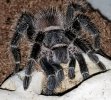- Messages
- 2
I have wanted a tarantula since I was a kid even tho I was afraid of spiders (lol) but when I started working at a pet store last year I had to work with them and actually liked them. I was curious what a good starter arboreal tarantula would be? all signs seem to point towards a Antilles pinktoe, but I am curious on what others would think are good starters that stay small. What would be the dimensions of something like a pinktoe?


